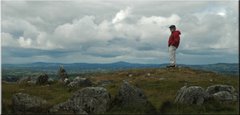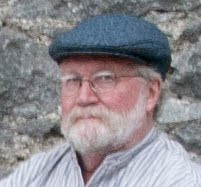Ruth recently posted this superb entry on her blog, which involved (among much else) reference to what things we hold so dear, outside of ourselves, that we would be irreparably lessened by their loss. Recently, two strikes of wildfire close to Ft. Harrington in the Santa Cruz Mountains have brought that issue into the forefront of our minds as well (as has the much vaster tragedy farther away, along the Mississippi.) The first local inferno was the “Summit Fire” in early June, which destroyed many homes in my friend Karl von Ahnen’s neighborhood, and the second was the fire on Ben Lomond Mountain, within sight of Ft. Harrington, that destroyed homes in the town of Bonny Doon, including this one:
 John Steed sifting through rubble that a day ago was home. Photo by Lucjan Szewczyk, San Lorenzo Valley Press-Banner, permission pending.
John Steed sifting through rubble that a day ago was home. Photo by Lucjan Szewczyk, San Lorenzo Valley Press-Banner, permission pending.Two wildfires within twenty miles of Ft. Harrington was enough to spur us to ready ourselves for evacuation. It is just June, and the high fire season hereabouts is generally three to four months from now, three or four months that generally provide no rain at all. This whole area is explosive now, and it’s only prudent to upgrade to “probable” what we used to think of as “unlikely.”
So we prepare to evacuate. And the first thing to do is to decide what we can’t do without, and what we couldn’t live with ourselves for leaving behind.
We can’t do without each other, so we’ve established all connection possibilities for any time of day. We couldn’t live with ourselves if we hadn’t arranged for evacuation of all of our mammals (sorry, chickens), so their portable cages and emergency supplies are right at the front of the shed by where the trucks are usually parked.
So, what else? Insurance papers? No, everything of importance is digitized. Birth certificates? Passports? No, all of that sort of thing can be replaced now without actual pieces of paper involved.
So that leaves photos and my Dad’s voluminous diaries and unpublished stories. And that’s what I’ve been spending just about all of my “free” time working on for the last month: backing up, duplicating, and distributing in various media to various places all of that stuff.
Along the way, just a few days ago, I ploughed my way through the scanning of Dad’s slides from our spring trip south in 1961. We lived in upstate New York, but my mother’s family was (and is) in Atlanta, so we periodically traveled the thousand miles from Norwich, NY, to Atlanta, Georgia, usually at Christmastime and Easter. By 1961, we had settled into a Spring auto trip routine that would continue annually until 1965: Norwich – Myrtle Beach, South Carolina – Daytona Beach, Florida – Atlanta, and back.
What struck me after a while was how modern all of those photos from 47 years ago looked, and, on further head-scratching, how unexceptional our experiences were compared to what they would have been if the trip had been taken in 2008 instead of 1961.
1961 was 47 years ago. 47 years before 1961 was 1914. I don’t know for sure, since I don’t have access to a collection of home snapshots from 1914, but I’d imagine that the differences between 1914 and 1961 would be vastly more than those from 1961 to now.
I’m not talking about “big-picture” things, like politics, or about faddish things, like zoot suits or hippie garb or parachute pants. I’m talking about day-to-day, grinding, boring, what-life’s-like things, such as how we go from one place to another, how we’re entertained, and whether or not our streets are paved.
For example, in 1914, the trip would have been made by rail, not road. Entertainment would have been by person, not by radio or recording. Roads, mostly would be unpaved, not paved. And so on, and so on, and so on. But the differences between 1961 and 2008, as far as their impact on a pre-adolescent int he back seat, would have been negligible.
So, why was there such a big difference between how we lived in 1914 and 1961, but not so much of a difference between 1961 and 2008?
The easy answer would be that we had a huge war between 1914 and 1961 (or two huge wars, depending on whether you treat 1918 – 1937 as an interstice or a breather – machts nichts) that force-fed technological change at an unprecedented rate. But I’m not sure.
I’m not sure that the difference is even real, frankly.
Maybe we always see things that happen within our own lifetimes as familiar, but those before it as quaint and strange. Maybe if I were writing this in 1961, looking back at photos from 1914, I’d be marveling at how different 1914 was from 1867. And maybe it was.
But would one of my ancestors in 1647 think that 1600 was pretty modern, but 1553 was odd?
Dunno. But here’s your challenge: can you identify things in the below photos from 1961 that mark them as from then, not from now? Have at it in comments, folks.
Dad and me at a motel swimming pool in Virginia on the way home, 1961. This is the precise way that I even now view his and my relationship to one another.











10 comments:
I'm probably missing things but I think you are correct, with one exception: the ladies are so properly attired in dresses and, I'm sure, stockings. While some 2008 Moms and/or Grandmas do occasionally dress something like that, neither Diane nor I do.
Looking at our old travel photos I have been struck by seeing the same two dresses in them year after year. They were perfect for travelling with a bunch of children: a dark plaid, and a busy floral. Many untoward events could occur without marring the overall appearance of ladylike couture.
Also - the trees at Brookgreen are even bigger now.
Ronnie
Right, Ronnie -- and, while I didn't include any in this post, many of Dad's photos from that time frame show men wearing dressy hats. Some blame (or credit) JFK's hatless inaugural for the demise of that convention.
Excluding the short shorts, glass soda bottles, aluminum beach chairs, vintage vehicles, unpaved driveway, and juke box.....I'm stumped.
The Chuck Taylors you were wearing are still very much in style.
And correct me if I'm wrong, but that solar panel seems WAY ahead of it's time.
Grandad looks pretty buff in his retro-speedo.
This is fun. More please.
Happy 61st birthday dad (june 20th)!!
Adam Harrington-
A little Googling shows that the solar panel (actually a solar water heater) was a little behind its time when the picture was taken. Turns out that most Florida homes built between 1920 and 1950 or so were equipped with solar water heaters. The end of that practice came with cheap electricity, and with the power company's aggressive marketing, including giving away electric water heaters to boost power consumption.
You mean the aluminum beach chairs I bought last year were antiques?
Ronnie
Brookgreen! I keep meaning to do a Brookgreen entry but my pictures are always disappointing.
I think ronnie's right - the attire of the ladies is the main difference (and of course the car in the Orland pic). Glass bottles seem to have made a comeback, and so have diners! What's that at bottom right in the shuffleboard photo? Looks like it could be a car fin. My first car was a '61 with fins.
I think cars and radio thrust us into the basic form of daily life that we're still in. WWI and its part in all that is a bigger topic than i can wrap my brain around, but it's a big part.
I was just looking at a Georgia O'Keeffe book i got on sale yesterday, and she had a NY cityscape phase in the '20's --
(Dern! hard to see that row of headlights in the background, in this tiny version, but here it is:
http://tinyurl.com/5qfzmm )
And i thought, Yep, the era of long highway ribbons of moving headlights at night was unimaginable 15-20 years before, and hasn't altered a lot since. That's a world i'd slip right into if i got dropped there.
Oh and happy birthday!
Not much to add beyond the hope that you had a most happy of birthdays.
Regards,
Dann
What Dann said!!!
Hippo Birdies Two Ewes!
The colour in those photos has held up remarkably well. They could've been taken yesterday. (But for the life/style differences we've been discussing...)
(the other) ronnie
Every day the news of the fires is scarier than the day before. I'm glad you have a detailed evacuation plan but I sure hope you don't have to use it!
Ronnie (no cat)
Thanks for your wishes, Ronnie, and I sure hope we don't have to abandon Fort, too. It is indeed scary around here; when I crested the ridge yesterday evening on the way home (generally westward of where I work), the sun was at least thirty degrees up above the horizon, but, because of all the smoke in the air, it had the orange-globe look it frequently has at sunset.
ronnie-with-a-cat: Your remark about the colour in the slides is going to require a whole new post to address.
Post a Comment